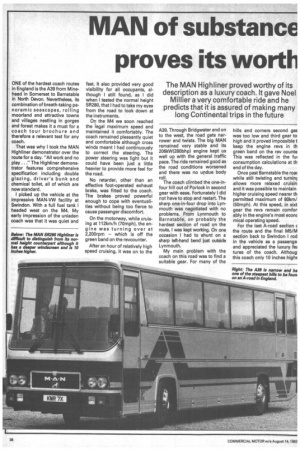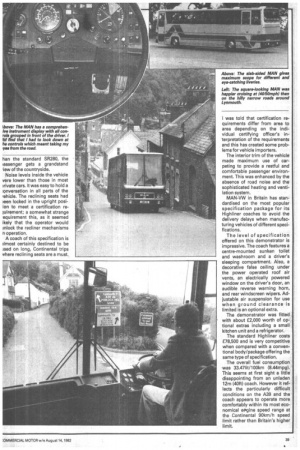MAN of substance proves its worth
Page 28

Page 29

If you've noticed an error in this article please click here to report it so we can fix it.
The MAN Highliner proved worthy of its description as a luxury coach. It gave Noel Millier a very comfortable ride and he predicts that it is assured of making many long Continental trips in the future
ONE of the hardest coach routes in England is the A39 from Minehead in Somerset to Barnstable in North Devon. Nevertheless, its combination of breath-taking panoramic seascapes, rolling moorland and attractive towns and villages nestling in gorges and forest makes it a must for a coach tour brochure and therefore a relevant test for any coach.
That was why I took the MAN Highliner demonstrator over the route for a day. "All work and no play. ..." The Highliner demonstrator features comprehensive specification including double glazing, driver's bunk and chemical toilet, all of which are now standard.
I picked up the vehicle at the impressive MAN-VW facility at Swindon. With a full fuel tank I headed west on the M4. My early impression of the unladen coach was that it was quiet and fast. It also provided very good visibility for all occupants, although I still found, as I did when I tested the normal height SR280, that I had to take my eyes from the road to look down at the instruments.
On the M4 we soon reached the legal maximum speed and maintained it comfortably. The coach remained pleasantly quiet and comfortable although cross winds meant I had continuously to correct the steering. The power steering was light but it could have been just a little heavier to provide more feel for the road.
No retarder, other than an effective foot-operated exhaust brake, was fitted to the coach. The brakes proved powerful enough to cope with eventualities without being too fierce to cause passenger discomfort.
On the motorway, while cruising at 112km/h (70mph), the engine was turning over at 2,200rpm — which is off the green band on the revcounter.
After an hour of relatively high speed cruising, it was on to the A39. Through Bridgwater and on to the west, the road gets narrower and twists. The big MAN remained very stable and its 206kW(280bhp) engine kept us well up with the general traffic pace. The ride remained good as the road conditions worsened and there was no undue body roll.
The coach climbed the one-infour hill out of Porlock in second gear with ease. Fortunately I did not have to stop and restart. The sharp one-in-four drop into Lynmouth was negotiated with no problems. From Lynmouth to Barnstable, on probably the hardest section of road on the route, I was kept working. On one occasion I had to shunt on a sharp left-hand bend just outside Lyn mouth.
My main problem with the coach on this road was to find a suitable gear. For many of the hills and corners second gei was too low and third gear to high and it proved impossible t keep the engine revs in th green band on the rev counte This was reflected in the fu4 consumption calculations at th end of the day.
Once past Barnstable the roac while still twisting and turninc allows more relaxed cruisin and it was possible to maintain higher cruising speed nearer th permitted maximum of 80km/ (50mph). At this speed, in sixt gear the revs remain comfor ably in the engine's most econc mical operating speed.
For the last A-road section c the route and the final M5/M section back to Swindon I rod in the vehicle as a passenge and appreciated the luxury fez tures of the coach. Althoug this coach only 10 inches highE han the standard SR280, the lassenger gets a grandstand iew of the countryside.
Noise levels inside the vehicle vere lower than those in most wivate cars. It was easy to hold a onversation in all parts of the vehicle. The reclining seats had )een locked in the upright posiion to meet a certification reiuirement; a somewhat strange equirement this, as it seemed ikely that the operator would mlock the recliner mechanisms n operation.
A coach of this specification is dmost certainly destined to be ised on long, Continental trips vhere reclining seats are a must. I was told that certification requirements differ from area to area depending on the individual certifying officer's interpretation of the requirements and this has created some problems for vehicle importers.
The interior trim of the vehicle made maximum use of carpeting to provide a restful and comfortable passenger environment. This was enhanced by the absence of road noise and the sophisticated heating and ventilation system.
MAN-VW in Britain has standardised on the most popular specification package for its Highliner coaches to avoid the delivery delays when manufacturing vehicles of different specifications.
The level of specification offered on this demonstrator is impressive. The coach features a centre-mounted sunken toilet and washroom and a driver's sleeping compartment. Also, a decorative false ceiling under the power operated roof air vents, an electrically powered window on the driver's door, an audible reverse warning horn, and rear windscreen wipers. Adjustable air suspension for use when ground clearance is limited is an optional extra.
The demonstrator was fitted with about £2,000 worth of optional extras including a small kitchen unit and a refrigerator.
The standard Highliner costs £78,500 and is very competitive when compared with a conventional body/package offering the same type of specification.
The overall fuel consumption was 33.471it/100km (8.44mpg). This seems at first sight a little disappointing from an unladen 12m (40ft) coach. However it reflects the particularly difficult conditions on the A39 and the coach appears to operate more comfortably within its most economicat emgine speed range at the Continental 90km/h speed limit rather than Britain's higher limit.














































